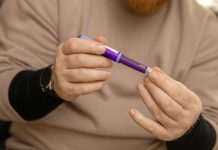
Imagine experiencing the world around you becoming increasingly blurred, losing the ability to see the faces of your loved ones clearly, or struggling to read your favorite books.
For nearly 8 million Americans, this is a reality due to diabetic eye diseases, specifically proliferative diabetic retinopathy and diabetic macular edema.
According to estimates by the National Institutes of Health, this number might almost double by 2040.
In the world within our eyes, particularly the retina, diabetes wreaks havoc in two prevalent ways: by causing excessive growth of new blood vessels, which may lead to bleeding or retinal detachments (proliferative diabetic retinopathy), or by making the blood vessels leak fluid, swelling the retina and damaging vital vision cells (diabetic macular edema).
Both conditions can significantly impair our vision, diminishing the quality of life and independence for affected individuals.
The Potential of 32-134D: A Beacon of Hope
In a sea of concerning statistics, a beacon of hope emerges from researchers at Wilmer Eye Institute, Johns Hopkins Medicine.
A study, illuminated in the Journal of Clinical Investigation on May 25, brings to light a compound named 32-134D, which may be a game-changer in preventing or mitigating vision loss for people with diabetes.
This compound operates by diminishing levels of a protein called HIF (hypoxia-inducible factor).
The science might sound intricate, but envision HIF as a switch operator. It can turn certain genes, like VEGF (vascular endothelial growth factor), on or off, controlling blood vessel production and leakiness in the retina, which is crucial for clear vision.
Elevated levels of HIF, therefore, escalate blood vessel creation and leakage, paving the path to vision loss.
Intriguingly, 32-134D, which has previously demonstrated its mettle in slowing liver tumor growth in mice, presented a noteworthy capacity to safely and effectively reduce HIF levels in diseased eyes.
Trials and Triumphs: Testing 32-134D
To delve into how 32-134D could help, researchers exposed various human retinal cell lines to it, witnessing that genes regulated by HIF normalized, thereby ceasing new blood vessel formation and preserving existing blood vessels’ integrity.
Further trials on two different adult mouse models of diabetic eye disease revealed that even a single injection of 32-134D could reduce HIF levels, inhibit new blood vessel formation, block vessel leakage, and maintain its active levels for about 12 days without inflicting harm to retinal cells or tissue.
Dr. Akrit Sodhi, M.D., Ph.D., and a principal contributor to the study, radiates cautious optimism. “Inhibiting HIF with 32-134D is not just potentially effective, but also safe,” he shares.
His voice reflects a poignant awareness that diabetic eye disease is not an isolated medical term.
It affects our relatives, friends, and colleagues – it’s a challenge encroaching upon an increasingly large segment of our communities, requiring not just effective, but safe therapies, especially considering the existing treatment involving anti-VEGF therapies via eye injections might not be effective for many and may harbor side effects with long-term use.
Future Focus: The Path Ahead for 32-134D
While the findings fan the flames of hope, Dr. Sodhi emphasizes the necessity for additional studies in animal models before graduating to clinical trials.
The journey from a promising compound to a validated, widely accessible treatment is intricate and necessitates meticulous research and validation.
However, the vision (both literal and metaphorical) is clear: to illuminate a path where people with diabetes are not inexorably bound to vision loss, where the blurring of their world can be halted, or better yet, prevented.
With a dedicated focus on research, ongoing trials, and future endeavors, the aim is to transform the hopeful promise of 32-134D into a tangible reality for millions, safeguarding their ability to see, experience, and navigate the world with clarity and confidence.
If you care about diabetes, please read studies that pomace olive oil could help lower blood cholesterol, and honey could help control blood sugar.
For more information about diabetes, please see recent studies about Vitamin D that may reduce dangerous complications in diabetes and results showing plant-based protein foods may help reverse type 2 diabetes.
The research findings can be found in the Journal of Clinical Investigation.
Follow us on Twitter for more articles about this topic.
Copyright © 2023 Knowridge Science Report. All rights reserved.



